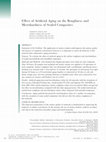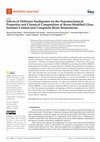Papers by André Luiz Fraga Briso
Brazilian Journal of Health Review, Feb 27, 2024
Acta odontológica latinoamericana, Dec 19, 2022

Archives of Health Investigation, Dec 30, 2017
A tecnica da microabrasao tem sido empregada em muitos casos de manchamento intrinseco e superfic... more A tecnica da microabrasao tem sido empregada em muitos casos de manchamento intrinseco e superficial do esmalte dental, onde utiliza-se um produto microabrasivo com intuito de abrasionar a superficie dental afim de remover ou amenizar as manchas, melhorando a estetica e lisura superficial. Sendo assim, o objetivo deste trabalho foi a realizacao de serie de casos para remocao de manchas de esmalte utilizando a tecnica de microabrasao. O primeiro caso clinico apresentava manchas dispersas que se localizavam dos dentes 14 ao 24. Previamente a microabrasao, foi realizado clareamento caseiro utilizando Opalescence 10% (Ultradent) durante 4 semanas associado ao clareamento in office com Boost 38% (Ultradent) por uma sessao. Na sequencia, foi realizado o procedimento microabrasivo, utilizando opalustre (Ultradent). O segundo caso apresentava paciente com manchas intrinsecas nos dentes 21 e 13, e anteriormente a tecnica abrasiva, optou-se pela realizacao do clareamento in office utilizando Whitness HP 35% (FGM), por 3 sessoes. Apos as sessoes clareadoras, os dentes aproximaram-se da cor B1 (escala Vita), e entao, apos uma semana, foi realizada a tecnica de microabrasao utilizando opalustre (Ultradent). O terceiro caso clinico foi realizado clareamento in office empregando Whiteness HP 35% (FGM) por uma sessao, onde evidenciou-se manchas do 13 ao 23 decorrentes de fluorose, dessa maneira, optou-se pela realizacao da tecnica de microabrasao utilizando opalustre (Ultradent); na sequencia, prosseguiu-se o clareamento caseiro por 2 semanas. O quarto caso clinico apresentava paciente apos tratamento ortodontico, onde foi realizada a tecnica de microabrasao, utilizando opalustre (Ultradent), como auxiliar para remocao de resina proveniente da colagem de brackets ortodonticos. Conclusoes: o emprego isolado da tecnica de microabrasao, nem sempre alcanca resultados satisfatorios, sendo preciso associar outras tecnicas afim de alcancar uma estetica agradavel para resolucao de manchas. Descritores: Esmalte Dentario; Fluorose Dentaria; Hipoplasia do Esmalte Dentario; Microabrasao do Esmalte.
Journal of prosthodontic research, 2023
Operative Dentistry, 2016

Journal of Esthetic and Restorative Dentistry, Oct 1, 2010
Statement of the Problem: The application of surface sealant could improve the surface quality an... more Statement of the Problem: The application of surface sealant could improve the surface quality and success of composite restorations; however, it is important to assess the behavior of this material when subjected to aging procedures. Purpose: To evaluate the effect of artificial aging on the surface roughness and microhardness of sealed microhybrids and nanofilled composites. Materials and Methods: One hundred disc-shaped specimens were made for each composite. After 24 hours, all samples were polished and surface sealant was applied to 50 specimens of each composite. Surface roughness (Ra) was determined with a profilometer and Knoop microhardness was assessed with a 50-g load for 15 seconds. Ten specimens of each group were aged during 252 hours in a UV-accelerated aging chamber or immersed for 28 days in cola soft drink, orange juice, red wine staining solutions, or distilled water. Data were analyzed by twoway analysis of variance and Fischer's test (a = 0.05). Results: Artificial aging decreased microhardness values for all materials, with the exceptions of Vit-l-escence (Ultradent Products Inc., South Jordan UT, USA) and Supreme XT (3M ESPE, St. Paul, MN, USA) sealed composites; surface roughness values were not altered. Water storage had less effect on microhardness, compared with the other aging processes. The sealed materials presented lower roughness and microhardness values, when compared with unsealed composites. Conclusions: Aging methods decreased the microhardness values of a number of composites, with the exception of some sealed composites, but did not alter the surface roughness of the materials. CLINICAL SIGNIFICANCE The long-term maintenance of the surface quality of materials is fundamental to improving the longevity of esthetic restorations. In this manner, the use of surface sealants could be an important step in the restorative procedure using resin-based materials.

Journal of Dentistry, Aug 1, 2021
OBJECTIVES To evaluate obliterating capability and biological performance of desensitizing agents... more OBJECTIVES To evaluate obliterating capability and biological performance of desensitizing agents. METHODS 50 dentin blocks were distributed according to the desensitizing agent used (n=10): Control (Artificial saliva); Ultra EZ (Ultradent); Desensibilize Nano P (FGM); T5-OH Bioactive Glass (Experimental solution); F18 Bioactive Glass (Experimental solution). Desensitizing treatments were performed for 15 days. In addition, specimens were subjected to acid challenge to simulate oral environment demineralizing conditions. Samples were subjected to permeability analysis before and after desensitizing procedures and acid challenge. Cytotoxicity analysis was performed by using Alamar Blue assay and complemented by total protein quantification by Pierce Bicinchoninic Acid assay at 15 minutes, 24-hour and 48-hour time points. Scanning electron microscopy and energy dispersion X-ray spectroscopy were performed for qualitative analysis. Data of dentin permeability was analyzed by two-way repeated measures ANOVA and Tukey's test. For cytotoxicity, Kruskal-Wallis and Newman-Keuls tests. RESULTS for dentin permeability there was no significant difference among desensitizing agents after treatment, but control group presented highest values (0.131 ± 0.076 Lp). After acid challenge, control group maintained highest values (0.044 ± 0.014 Lp) with significant difference to other groups, except for Desensibilize Nano P (0.037 ± 0.019 Lp). For cytotoxicity, there were no significant differences among groups. CONCLUSION Bioglass-based desensitizers caused similar effects to commercially available products, regarding permeability and dentin biological properties. CLINICAL SIGNIFICANCE There is no gold standard protocol for dentin sensitivity. The study of novel desensitizing agents that can obliterate dentinal tubules in a faster-acting and long-lasting way may help meet this clinical need.
Journal of Health Sciences, Feb 23, 2018

Operative Dentistry, 2022
SUMMARY This study aimed to evaluate the effect of the bleaching gel application site on chromati... more SUMMARY This study aimed to evaluate the effect of the bleaching gel application site on chromatic changes and postoperative sensitivity in teeth. Thirty patients were selected and allocated to three groups (n=10 per group), according to the location of the gel: GI, cervical application; GII, incisal application; and GIII, total facial. The amount and time of application of the 35% hydrogen peroxide (H2O2) gel were standardized. Color changes were analyzed by ΔE and Wid (bleaching index), using the values obtained in the readings conducted on a digital spectrophotometer in the cervical (CRs) and incisal regions (IRs) of the teeth. Spontaneous sensitivity was assessed using the questionnaire, and the stimulated sensitivity caused by the thermosensory analysis (TSA). The analysis occurred in five stages: baseline, after the first, second, and third whitening sessions (S), and 14 days after the end of the whitening, using the linear regression statistical model with mixed effects and post-test by orthogonal contrasts (p<0.05). Although the IR was momentarily favored, at the end of the treatment, the restriction of the application site provided results similar to those obtained when the gel was applied over the entire facial surface. Regarding sensitivity, only the GI showed spontaneous sensitivity. In the TSA, GIII had less influence on the threshold of the thermal sensation. It was concluded that the chromatic alteration does not depend on the gel application site. Spontaneous sensitivity is greater when the gel is concentrated in the cervical region (CR), and the teeth remain sensitized by thermal stimuli even after 14 days.
International Journal of Periodontics & Restorative Dentistry, Mar 1, 2016

Archives of Health Investigation, Jan 27, 2017
Objetivo: Investigar os efeitos de diferentes protocolos de aplicacao do remineralizante MI Paste... more Objetivo: Investigar os efeitos de diferentes protocolos de aplicacao do remineralizante MI Paste Plus sobre o tecido pulpar de molares de ratos Wistar clareados. Metodos: Sessenta ratos foram divididos em: Controle- sem tratamento; Cla- aplicacao de peroxido de hidrogenio (H 2 O 2 ) 35%(30 minutos); Cla-Rem- H 2 O 2 35%, seguido da MI Paste Plus (30 minutos); Rem-Cla- MI Paste Plus, seguida do H 2 O 2 35%; Rem-Cla-Rem- MI Paste Plus antes e apos o H 2 O 2 35%; Cla+Rem- mistura do H 2 O 2 35% com MI Paste Plus (1:1). Apos 2 e 30 dias, os ratos foram mortose as maxilas processadas para analise com Hematoxilina-Eosina, atribuindo escores a inflamacao.Os dados foram submetidos aos testes de Kruskal-Wallis e Dunn (p 0,05); nao houve diferenca entre os grupos clareados (p 0,05); nao houve diferenca entre os demais grupos clareados (p>0,05). No terco cervical, Cla e Cla-Rem apresentaram inflamacao moderada, e os demais grupos clareados, leve; houve diferenca entre Cla e Cla-Rem com Controle e Cla+Rem (p 0,05). Conclusao: O uso da MI Paste Plus antes e/ou apos o gel clareador nao influenciou os efeitos no tecido pulpar, entretanto a mistura da MI Paste Plus com o gel clareador promoveu menor inflamacao. (Apoio: FAPESP 2015/10984-3)
Revista de Odontologia da UNESP, 2014
Clinical Oral Investigations, May 13, 2022
Journal of Applied Oral Science, 2019
Dentistry journal, Jul 17, 2023

Photodiagnosis and Photodynamic Therapy, Mar 1, 2021
BACKGROUND The purpose of this study was to investigate the effect of a novel dental bleaching te... more BACKGROUND The purpose of this study was to investigate the effect of a novel dental bleaching technique with Violet LED on enamel color change, bond strength and hybrid layer nanomechanical properties in resin-dentin restoration, and dentin biostability. METHODS A total of 125 bovine incisors were distributed into a control group, violet LED group (LED), and 35% peroxide hydrogen bleaching gel (BLG) groups (n = 15). Three 45-minute sessions were performed for both bleaching procedures every week. Enamel color change (ΔE, ΔL, and Δb) was determined after every bleaching session. After color analysis, dentin was exposed for the resin-dentin bond strength analysis using microtensile test and evaluation of the nanomechanical properties at the hybrid layer (nanohardness). While half of the specimens were tested immediately, the remaining were evaluated after 10,000 thermal cycles (TC). Thirty additional teeth were used to investigate dentin ultimate tensile strength (UTS) after the bleaching treatments. UTS was evaluated before and after an enzymatic challenge. Two-way repeated measures ANOVA and Tukey's post-test were used for the statistical analysis (α = 0.05). RESULTS Enamel bleaching effect was observed in the LED and BLG groups with significant alterations in the ΔE, ΔL, and Δb in the BLG group. No difference was observed in the resin-dentin bond strength among the groups (p > 0.05), however, TC negatively affected the bond strength values for all the groups. Nanomechanical properties remained unchanged when comparing immediate and after TC results (p > 0.05). Bleaching with BLG reduced significantly the dentin UTS, while all groups showed major decrease in UTS after the enzymatic challenge. CONCLUSIONS Although violet LED was able to promote a bleaching effect, less color changes was observed when compared to BLG. None of the bleaching techniques affected the resin-bond strength or the nanomechanics of the hybrid layer. Violet LED did negatively affect dentin biostability as observed for BLG and it may promote less changes to the organic content of dentin.

Purpose: This study aimed to evaluate the nanomechanical properties and chemical composition of r... more Purpose: This study aimed to evaluate the nanomechanical properties and chemical composition of restorative materials and dental surfaces using different toothpastes. Methods: Enamel (n=60) and dentin (n=60) bovine blocks were obtained and restored using resin-modified glass ionomer cement (RMGIC, n=30) or composite resin (CR, n=30) to form the dentin adjacent to RMGIC (DRMGIC), enamel adjacent to RMGIC (ERMGIC), dentin adjacent to CR (DCR), and enamel adjacent to CR (ECR). After restoration, one hemiface of each specimen was coated with an acid-resistant varnish to create the control (C) and eroded (E) sides (erosion: 5 days, 4 × 2 min/day; 1% citric acid / abrasion: 2 × 15 s followed by immersion on slurries 2 min). Three toothpastes were used: without fluoride (WF; n=10), sodium fluoride (NaF; n=10), and stannous fluoride (SnF2; n=10). The specimens were analyzed for nanohardness (H), elastic modulus (Er), and chemical composition using energy-dispersive X-ray spectroscopy (EDS) ...











Uploads
Papers by André Luiz Fraga Briso